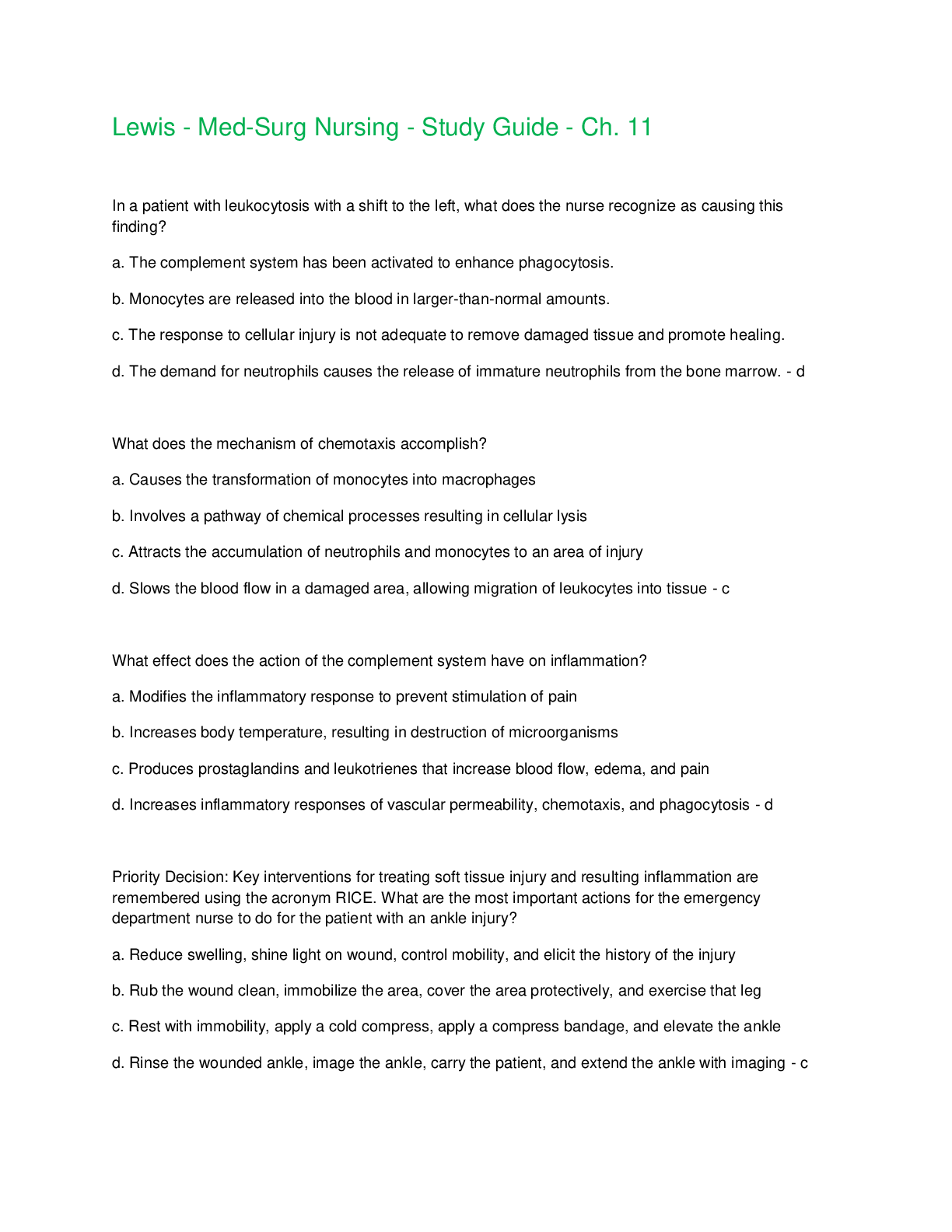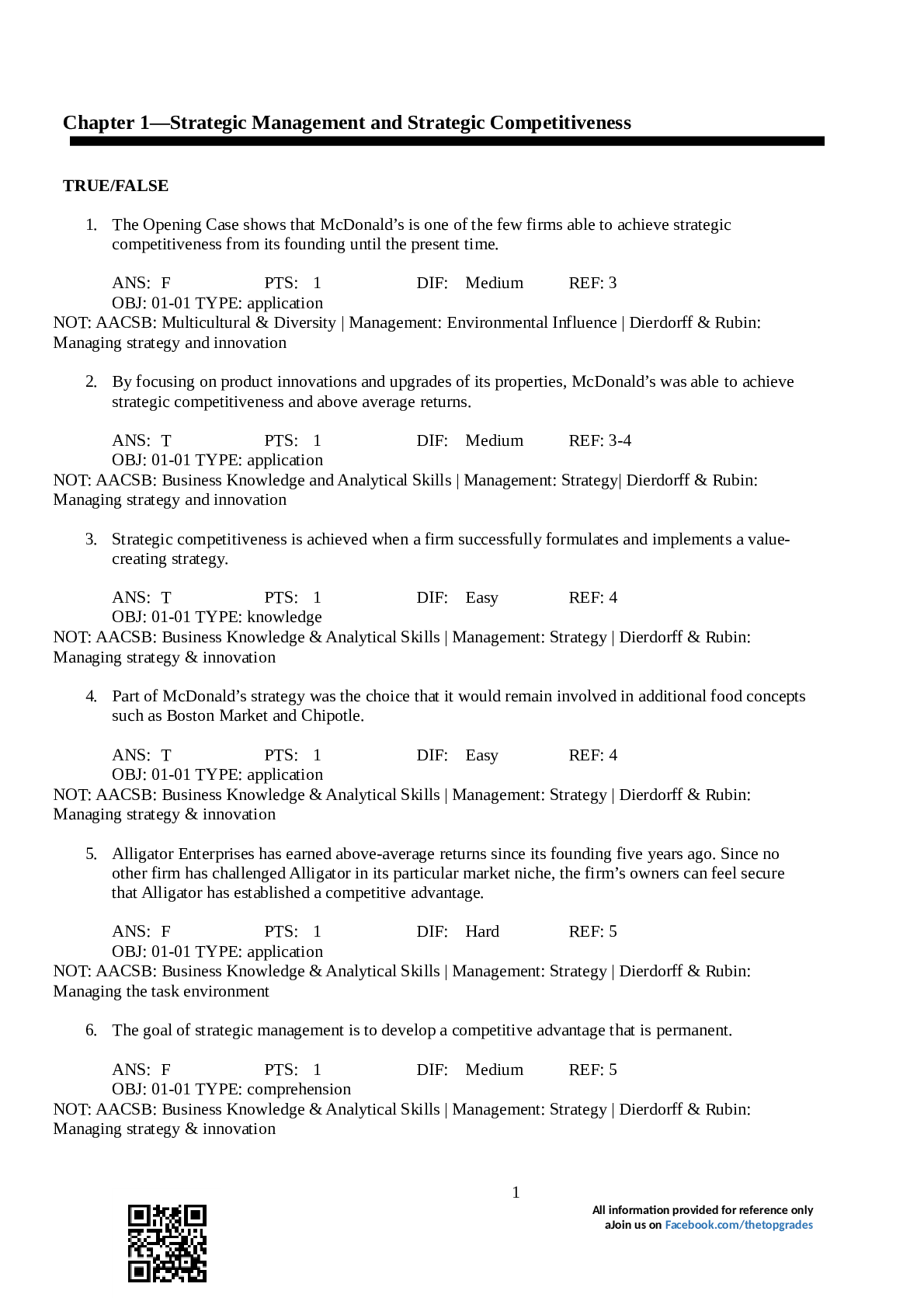Lewis - Med-Surg Nursing - Study Guide - Ch. 11 Questions And Answers
Document Content and Description Below
Lewis - Med-Surg Nursing - Study Guide - Ch. 11 Questions And Answers In a patient with leukocytosis with a shift to the left, what does the nurse recognize as causing this finding? a. The compl... ement system has been activated to enhance phagocytosis. b. Monocytes are released into the blood in larger-than-normal amounts. c. The response to cellular injury is not adequate to remove damaged tissue and promote healing. d. The demand for neutrophils causes the release of immature neutrophils from the bone marrow. - ANS- d What does the mechanism of chemotaxis accomplish? a. Causes the transformation of monocytes into macrophages b. Involves a pathway of chemical processes resulting in cellular lysis c. Attracts the accumulation of neutrophils and monocytes to an area of injury d. Slows the blood flow in a damaged area, allowing migration of leukocytes into tissue - ANS- c What effect does the action of the complement system have on inflammation? a. Modifies the inflammatory response to prevent stimulation of pain b. Increases body temperature, resulting in destruction of microorganisms c. Produces prostaglandins and leukotrienes that increase blood flow, edema, and pain d. Increases inflammatory responses of vascular permeability, chemotaxis, and phagocytosis - ANS- d Priority Decision: Key interventions for treating soft tissue injury and resulting inflammation are remembered using the acronym RICE. What are the most important actions for the emergency department nurse to do for the patient with an ankle injury? a. Reduce swelling, shine light on wound, control mobility, and elicit the history of the injury b. Rub the wound clean, immobilize the area, cover the area protectively, and exercise that leg c. Rest with immobility, apply a cold compress, apply a compress bandage, and elevate the ankle d. Rinse the wounded ankle, image the ankle, carry the patient, and extend the ankle with imaging - ANS- c What is characteristic of chronic inflammation? a. It may last 2 to 3 weeks. b. The injurious agent persists or repeatedly injures tissue. c. Infective endocarditis is an example of chronic inflammation. d. Neutrophils are the predominant cell type at the site of inflammation. - ANS- b During the healing phase of inflammation, which cells would be mostly likely to regenerate? a. Skin b. Neurons c. Cardiac muscle d. Skeletal muscle - ANS- a What is the primary difference between healing by primary intention and healing by secondary intention? a. Secondary healing requires surgical debridement for healing to occur. b. Primary healing involves suturing two layers of granulation tissue together. c. Presence of more granulation tissue in secondary healing results in more scarring. d. Healing by secondary intention takes longer because more steps in the healing process are necessary. - ANS- c A patient had abdominal surgery 3 months ago and calls the clinic with complaints of severe abdominal pain and cramping, vomiting, and bloating. What should the nurse most likely suspect as the cause of the patient's problem? a. Infection b. Adhesion c. Contracture d. Evisceration - ANS- b A patient had a complicated vaginal hysterectomy. The student nurse provided perineal care after the patient had a bowel movement. The student nurse tells the nurse there was a lot of light brown, smelly drainage seeping from the perianal area. What should the nurse suspect when assessing this patient? a. Dehiscence b. Hemorrhage c. Keloid formation d. Fistula formation - ANS- d Which nutrients aid in capillary synthesis and collagen production by the fibroblasts in wound healing? a. Fats b. Proteins c. Vitamin C d. Vitamin A - ANS- c What role do the B-complex vitamins play in wound healing? a. Decrease metabolism b. Protect protein from being used for energy c. Provide metabolic energy for the inflammatory process d. Coenzymes for fat, protein, and carbohydrate metabolism - ANS- d The patient is admitted from home with a stage II pressure ulcer. This wound is classified as a yellow wound using the red-yellow-black concept of wound care. What is the nurse likely to observe when she does her wound assessment? a. Serosanguineous drainage b. Adherent gray necrotic tissue c. Clean, moist granulating tissue d. Creamy ivory to yellow-green exudate - ANS- d What type of dressing will the nurse most likely use for the patient in Question 14? a. Dry, sterile dressing b. Absorptive dressing c. Negative pressure wound therapy d. Telfa dressing with antibiotic ointment - ANS- b CONTINUES... [Show More]
Last updated: 2 years ago
Preview 1 out of 4 pages

Buy this document to get the full access instantly
Instant Download Access after purchase
Buy NowInstant download
We Accept:

Reviews( 0 )
$8.00
Can't find what you want? Try our AI powered Search
Document information
Connected school, study & course
About the document
Uploaded On
Sep 13, 2022
Number of pages
4
Written in
Additional information
This document has been written for:
Uploaded
Sep 13, 2022
Downloads
0
Views
47


























